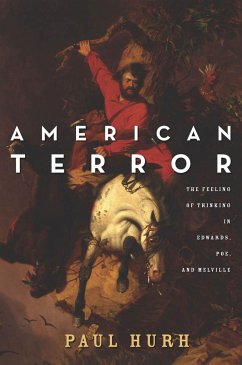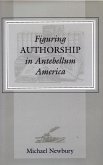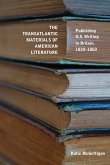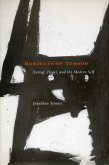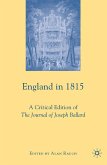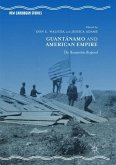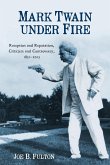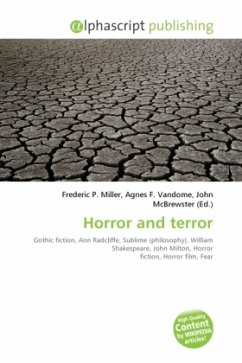- Gebundenes Buch
- Merkliste
- Auf die Merkliste
- Bewerten Bewerten
- Teilen
- Produkt teilen
- Produkterinnerung
- Produkterinnerung
Contrary to accounts that interpret terror in opposition to reason, this book shows how three authors famous for their works and theories of terror-Jonathan Edwards, Edgar Allan Poe, and Herman Melville-developed a terror that incorporates, theorizes, and extends the Enlightenment claims of reason as feeling.
Andere Kunden interessierten sich auch für
![Figuring Authorship in Antebellum America Figuring Authorship in Antebellum America]() Michael NewburyFiguring Authorship in Antebellum America82,99 €
Michael NewburyFiguring Authorship in Antebellum America82,99 €![The Transatlantic Materials of American Literature The Transatlantic Materials of American Literature]() Katie McGettiganThe Transatlantic Materials of American Literature99,99 €
Katie McGettiganThe Transatlantic Materials of American Literature99,99 €![Subjects of Terror Subjects of Terror]() Jonathan StraussSubjects of Terror100,99 €
Jonathan StraussSubjects of Terror100,99 €![England in 1815 England in 1815]() England in 181555,99 €
England in 181555,99 €![Guantánamo and American Empire Guantánamo and American Empire]() Guantánamo and American Empire21,99 €
Guantánamo and American Empire21,99 €![Mark Twain Under Fire Mark Twain Under Fire]() Joe B FultonMark Twain Under Fire55,99 €
Joe B FultonMark Twain Under Fire55,99 €![Horror and terror Horror and terror]() Horror and terror22,99 €
Horror and terror22,99 €-
-
-
Contrary to accounts that interpret terror in opposition to reason, this book shows how three authors famous for their works and theories of terror-Jonathan Edwards, Edgar Allan Poe, and Herman Melville-developed a terror that incorporates, theorizes, and extends the Enlightenment claims of reason as feeling.
Hinweis: Dieser Artikel kann nur an eine deutsche Lieferadresse ausgeliefert werden.
Hinweis: Dieser Artikel kann nur an eine deutsche Lieferadresse ausgeliefert werden.
Produktdetails
- Produktdetails
- Verlag: Stanford University Press
- Seitenzahl: 312
- Erscheinungstermin: 10. Juni 2015
- Englisch
- Abmessung: 231mm x 152mm x 23mm
- Gewicht: 522g
- ISBN-13: 9780804791144
- ISBN-10: 0804791147
- Artikelnr.: 41752258
- Herstellerkennzeichnung
- Libri GmbH
- Europaallee 1
- 36244 Bad Hersfeld
- gpsr@libri.de
- Verlag: Stanford University Press
- Seitenzahl: 312
- Erscheinungstermin: 10. Juni 2015
- Englisch
- Abmessung: 231mm x 152mm x 23mm
- Gewicht: 522g
- ISBN-13: 9780804791144
- ISBN-10: 0804791147
- Artikelnr.: 41752258
- Herstellerkennzeichnung
- Libri GmbH
- Europaallee 1
- 36244 Bad Hersfeld
- gpsr@libri.de
Paul Hurh is Associate Professor of English at the University of Arizona.
Contents and Abstracts
Introduction: Reopening Darkness
chapter abstract
The introduction lays out the problem of American literature's terror by
reviewing its critical history, defining it against related terms like
horror and the sublime, and fitting it within the current discourses of
affect theory and American literary history. It addresses the conceptual
methodological questions involved in thinking about feeling, and
conversely, in the idea that we might feel thinking. By way of this
discussion, the introduction situates the book's argument within recent
critical interest in American literary pragmatism and gothic posthumanism.
It also provides a map to the book's structure and previews the argument as
it develops from Edwards to Poe to Melville.
1Awakening Terror: Jonathan Edwards, Hellfire Preaching, and the Logic of
Revivalist Affect
chapter abstract
The first chapter argues, against current received understandings, that
Jonathan Edwards's terror was materially innovative and different, and that
the matter of its difference derives from Edwards's unique philosophical
interests and leads to his influential theorization of affect as a mode of
knowledge. Through a comparison of terror sermons across the late 17th and
early 18th centuries, this chapter discovers that the significance of
terror in New England turns from a cautionary and practical rhetoric to, in
later generations, an immanent and ideal rhetoric. The chapter shows how
Edwards's defense of terror preaching during the Great Awakening culminates
in a wholesale revolution in affective philosophy that derives from his
studies in formal logic and Enlightenment idealism, and is pinned to a
radical redefinition of the epistemological significance of terror.
2Critical Terrors: Poe's Early Horror and the Claims of Art after Jena
chapter abstract
This chapter argues that Poe's terror develops in concert with, and as a
complement to, his relentless and unforgiving literary criticism.
Considering the set of his tales, and one infamous poem, that share the
plot of a scholarly man haunted by the death and return of his beloved,
this chapter shows how those tales seek to incorporate and reframe the
impulse of the philosophy of art originating in the Jena school of
aesthetic criticism. Reading Poe's dead women tales as pieces that would
dramatize the interpretation of aesthetic effect, I show how Poe converts
the mere horror of the gruesome into a broader terror that attends the very
attempt to know, to locate and explain, the feeling of fear.
3The Air of Analysis: Resolution and Composition in Poe's Sublime and
Confessional Tales
chapter abstract
The third chapter argues that the analytical method on display in Poe's
detective fiction is drawn from and influential in structuring the dynamics
of terror in his confessional and sublime tales. My chapter returns to the
poststructuralist readings of Poe's detective fiction, and recovers in
response Poe's own definition of analysis as a bipartite system of
resolution and composition. By ascertaining the shape of analysis
responsible, ultimately, for the recursive and uncanny shape of the
poststructuralist debate, my chapter shows the continuity between Poe's
seemingly calculated tales of reason's mastery over nature and his
seemingly irrational tales of madness and peril. The second part of the
chapter finds and analyzes the same reciprocal dynamic of resolution and
composition within his sublime and confessional tales.
4The Uneven Balance: Dialectical Terror in Moby-Dick
chapter abstract
This chapter argues that the terror of Moby-Dick dramatizes the logical
paradoxes of a meta-dialectical method. It introduces a study of the
influence of Melville's close friend, George Adler, a proponent of Hegelian
metaphysics and a chronic paranoiac, upon Moby-Dick. And it shows how the
multiple terrors of Moby-Dick do not arise from one or the other
philosophical commitment, but rather from a Hegel-inspired application of
dialectical method to the problem of dialectical method itself. The chapter
analyzes how moments of precarious balance, in Moby-Dick, are paired with
an existential and epistemological terror. The chapter concludes with a
reading of how Melville models this dialectical terror upon the physical
properties of light.
5Dread: Space, Time, and Automata in The Piazza Tales
chapter abstract
This chapter considers the tone of dread unifying the disparate tales in
Melville's The Piazza Tales, and argues that the collection's construction
of terror underwrites specifically human encounters between felt subject
and perceived other. Drawing upon the spatial and temporal contours of
Kierkegaard's and Heidegger's theorization of dread, this chapter analyzes
how Melville's tales figure space and time within an unsettling affective
matrix that accords with how opens the possibility of perception in the
continental philosophical tradition. The chapter concludes that, through
the fatal automaton in "The Bell-Tower," Melville doesn't represent the
human as object, but rather the perfect human subject whose very
possibility is felt by the dread of our distance from it. Whereas this book
begins with the terrors of objectivity, Edwards's version of the will bound
inextricably to the terrors of hell, it ends with a portrait of the terror
of the perfect ideal subject.
Afterword: "some dim, random way"
chapter abstract
The afterword briefly summarizes the major conclusions of the book and
gestures at how they shift wider discussions about philosophy and
literature in general and American philosophy and American literature more
particularly. It hypothesizes that the focus on literary terror opens up a
new thread of intellectual history that parallels and contrasts with
several recent studies linking American literature and pragmatism. In this
possible new history, the dark strain in American literature leads, not to
pragmatism, but rather to its darker cousin, poststructuralism.
Introduction: Reopening Darkness
chapter abstract
The introduction lays out the problem of American literature's terror by
reviewing its critical history, defining it against related terms like
horror and the sublime, and fitting it within the current discourses of
affect theory and American literary history. It addresses the conceptual
methodological questions involved in thinking about feeling, and
conversely, in the idea that we might feel thinking. By way of this
discussion, the introduction situates the book's argument within recent
critical interest in American literary pragmatism and gothic posthumanism.
It also provides a map to the book's structure and previews the argument as
it develops from Edwards to Poe to Melville.
1Awakening Terror: Jonathan Edwards, Hellfire Preaching, and the Logic of
Revivalist Affect
chapter abstract
The first chapter argues, against current received understandings, that
Jonathan Edwards's terror was materially innovative and different, and that
the matter of its difference derives from Edwards's unique philosophical
interests and leads to his influential theorization of affect as a mode of
knowledge. Through a comparison of terror sermons across the late 17th and
early 18th centuries, this chapter discovers that the significance of
terror in New England turns from a cautionary and practical rhetoric to, in
later generations, an immanent and ideal rhetoric. The chapter shows how
Edwards's defense of terror preaching during the Great Awakening culminates
in a wholesale revolution in affective philosophy that derives from his
studies in formal logic and Enlightenment idealism, and is pinned to a
radical redefinition of the epistemological significance of terror.
2Critical Terrors: Poe's Early Horror and the Claims of Art after Jena
chapter abstract
This chapter argues that Poe's terror develops in concert with, and as a
complement to, his relentless and unforgiving literary criticism.
Considering the set of his tales, and one infamous poem, that share the
plot of a scholarly man haunted by the death and return of his beloved,
this chapter shows how those tales seek to incorporate and reframe the
impulse of the philosophy of art originating in the Jena school of
aesthetic criticism. Reading Poe's dead women tales as pieces that would
dramatize the interpretation of aesthetic effect, I show how Poe converts
the mere horror of the gruesome into a broader terror that attends the very
attempt to know, to locate and explain, the feeling of fear.
3The Air of Analysis: Resolution and Composition in Poe's Sublime and
Confessional Tales
chapter abstract
The third chapter argues that the analytical method on display in Poe's
detective fiction is drawn from and influential in structuring the dynamics
of terror in his confessional and sublime tales. My chapter returns to the
poststructuralist readings of Poe's detective fiction, and recovers in
response Poe's own definition of analysis as a bipartite system of
resolution and composition. By ascertaining the shape of analysis
responsible, ultimately, for the recursive and uncanny shape of the
poststructuralist debate, my chapter shows the continuity between Poe's
seemingly calculated tales of reason's mastery over nature and his
seemingly irrational tales of madness and peril. The second part of the
chapter finds and analyzes the same reciprocal dynamic of resolution and
composition within his sublime and confessional tales.
4The Uneven Balance: Dialectical Terror in Moby-Dick
chapter abstract
This chapter argues that the terror of Moby-Dick dramatizes the logical
paradoxes of a meta-dialectical method. It introduces a study of the
influence of Melville's close friend, George Adler, a proponent of Hegelian
metaphysics and a chronic paranoiac, upon Moby-Dick. And it shows how the
multiple terrors of Moby-Dick do not arise from one or the other
philosophical commitment, but rather from a Hegel-inspired application of
dialectical method to the problem of dialectical method itself. The chapter
analyzes how moments of precarious balance, in Moby-Dick, are paired with
an existential and epistemological terror. The chapter concludes with a
reading of how Melville models this dialectical terror upon the physical
properties of light.
5Dread: Space, Time, and Automata in The Piazza Tales
chapter abstract
This chapter considers the tone of dread unifying the disparate tales in
Melville's The Piazza Tales, and argues that the collection's construction
of terror underwrites specifically human encounters between felt subject
and perceived other. Drawing upon the spatial and temporal contours of
Kierkegaard's and Heidegger's theorization of dread, this chapter analyzes
how Melville's tales figure space and time within an unsettling affective
matrix that accords with how opens the possibility of perception in the
continental philosophical tradition. The chapter concludes that, through
the fatal automaton in "The Bell-Tower," Melville doesn't represent the
human as object, but rather the perfect human subject whose very
possibility is felt by the dread of our distance from it. Whereas this book
begins with the terrors of objectivity, Edwards's version of the will bound
inextricably to the terrors of hell, it ends with a portrait of the terror
of the perfect ideal subject.
Afterword: "some dim, random way"
chapter abstract
The afterword briefly summarizes the major conclusions of the book and
gestures at how they shift wider discussions about philosophy and
literature in general and American philosophy and American literature more
particularly. It hypothesizes that the focus on literary terror opens up a
new thread of intellectual history that parallels and contrasts with
several recent studies linking American literature and pragmatism. In this
possible new history, the dark strain in American literature leads, not to
pragmatism, but rather to its darker cousin, poststructuralism.
Contents and Abstracts
Introduction: Reopening Darkness
chapter abstract
The introduction lays out the problem of American literature's terror by
reviewing its critical history, defining it against related terms like
horror and the sublime, and fitting it within the current discourses of
affect theory and American literary history. It addresses the conceptual
methodological questions involved in thinking about feeling, and
conversely, in the idea that we might feel thinking. By way of this
discussion, the introduction situates the book's argument within recent
critical interest in American literary pragmatism and gothic posthumanism.
It also provides a map to the book's structure and previews the argument as
it develops from Edwards to Poe to Melville.
1Awakening Terror: Jonathan Edwards, Hellfire Preaching, and the Logic of
Revivalist Affect
chapter abstract
The first chapter argues, against current received understandings, that
Jonathan Edwards's terror was materially innovative and different, and that
the matter of its difference derives from Edwards's unique philosophical
interests and leads to his influential theorization of affect as a mode of
knowledge. Through a comparison of terror sermons across the late 17th and
early 18th centuries, this chapter discovers that the significance of
terror in New England turns from a cautionary and practical rhetoric to, in
later generations, an immanent and ideal rhetoric. The chapter shows how
Edwards's defense of terror preaching during the Great Awakening culminates
in a wholesale revolution in affective philosophy that derives from his
studies in formal logic and Enlightenment idealism, and is pinned to a
radical redefinition of the epistemological significance of terror.
2Critical Terrors: Poe's Early Horror and the Claims of Art after Jena
chapter abstract
This chapter argues that Poe's terror develops in concert with, and as a
complement to, his relentless and unforgiving literary criticism.
Considering the set of his tales, and one infamous poem, that share the
plot of a scholarly man haunted by the death and return of his beloved,
this chapter shows how those tales seek to incorporate and reframe the
impulse of the philosophy of art originating in the Jena school of
aesthetic criticism. Reading Poe's dead women tales as pieces that would
dramatize the interpretation of aesthetic effect, I show how Poe converts
the mere horror of the gruesome into a broader terror that attends the very
attempt to know, to locate and explain, the feeling of fear.
3The Air of Analysis: Resolution and Composition in Poe's Sublime and
Confessional Tales
chapter abstract
The third chapter argues that the analytical method on display in Poe's
detective fiction is drawn from and influential in structuring the dynamics
of terror in his confessional and sublime tales. My chapter returns to the
poststructuralist readings of Poe's detective fiction, and recovers in
response Poe's own definition of analysis as a bipartite system of
resolution and composition. By ascertaining the shape of analysis
responsible, ultimately, for the recursive and uncanny shape of the
poststructuralist debate, my chapter shows the continuity between Poe's
seemingly calculated tales of reason's mastery over nature and his
seemingly irrational tales of madness and peril. The second part of the
chapter finds and analyzes the same reciprocal dynamic of resolution and
composition within his sublime and confessional tales.
4The Uneven Balance: Dialectical Terror in Moby-Dick
chapter abstract
This chapter argues that the terror of Moby-Dick dramatizes the logical
paradoxes of a meta-dialectical method. It introduces a study of the
influence of Melville's close friend, George Adler, a proponent of Hegelian
metaphysics and a chronic paranoiac, upon Moby-Dick. And it shows how the
multiple terrors of Moby-Dick do not arise from one or the other
philosophical commitment, but rather from a Hegel-inspired application of
dialectical method to the problem of dialectical method itself. The chapter
analyzes how moments of precarious balance, in Moby-Dick, are paired with
an existential and epistemological terror. The chapter concludes with a
reading of how Melville models this dialectical terror upon the physical
properties of light.
5Dread: Space, Time, and Automata in The Piazza Tales
chapter abstract
This chapter considers the tone of dread unifying the disparate tales in
Melville's The Piazza Tales, and argues that the collection's construction
of terror underwrites specifically human encounters between felt subject
and perceived other. Drawing upon the spatial and temporal contours of
Kierkegaard's and Heidegger's theorization of dread, this chapter analyzes
how Melville's tales figure space and time within an unsettling affective
matrix that accords with how opens the possibility of perception in the
continental philosophical tradition. The chapter concludes that, through
the fatal automaton in "The Bell-Tower," Melville doesn't represent the
human as object, but rather the perfect human subject whose very
possibility is felt by the dread of our distance from it. Whereas this book
begins with the terrors of objectivity, Edwards's version of the will bound
inextricably to the terrors of hell, it ends with a portrait of the terror
of the perfect ideal subject.
Afterword: "some dim, random way"
chapter abstract
The afterword briefly summarizes the major conclusions of the book and
gestures at how they shift wider discussions about philosophy and
literature in general and American philosophy and American literature more
particularly. It hypothesizes that the focus on literary terror opens up a
new thread of intellectual history that parallels and contrasts with
several recent studies linking American literature and pragmatism. In this
possible new history, the dark strain in American literature leads, not to
pragmatism, but rather to its darker cousin, poststructuralism.
Introduction: Reopening Darkness
chapter abstract
The introduction lays out the problem of American literature's terror by
reviewing its critical history, defining it against related terms like
horror and the sublime, and fitting it within the current discourses of
affect theory and American literary history. It addresses the conceptual
methodological questions involved in thinking about feeling, and
conversely, in the idea that we might feel thinking. By way of this
discussion, the introduction situates the book's argument within recent
critical interest in American literary pragmatism and gothic posthumanism.
It also provides a map to the book's structure and previews the argument as
it develops from Edwards to Poe to Melville.
1Awakening Terror: Jonathan Edwards, Hellfire Preaching, and the Logic of
Revivalist Affect
chapter abstract
The first chapter argues, against current received understandings, that
Jonathan Edwards's terror was materially innovative and different, and that
the matter of its difference derives from Edwards's unique philosophical
interests and leads to his influential theorization of affect as a mode of
knowledge. Through a comparison of terror sermons across the late 17th and
early 18th centuries, this chapter discovers that the significance of
terror in New England turns from a cautionary and practical rhetoric to, in
later generations, an immanent and ideal rhetoric. The chapter shows how
Edwards's defense of terror preaching during the Great Awakening culminates
in a wholesale revolution in affective philosophy that derives from his
studies in formal logic and Enlightenment idealism, and is pinned to a
radical redefinition of the epistemological significance of terror.
2Critical Terrors: Poe's Early Horror and the Claims of Art after Jena
chapter abstract
This chapter argues that Poe's terror develops in concert with, and as a
complement to, his relentless and unforgiving literary criticism.
Considering the set of his tales, and one infamous poem, that share the
plot of a scholarly man haunted by the death and return of his beloved,
this chapter shows how those tales seek to incorporate and reframe the
impulse of the philosophy of art originating in the Jena school of
aesthetic criticism. Reading Poe's dead women tales as pieces that would
dramatize the interpretation of aesthetic effect, I show how Poe converts
the mere horror of the gruesome into a broader terror that attends the very
attempt to know, to locate and explain, the feeling of fear.
3The Air of Analysis: Resolution and Composition in Poe's Sublime and
Confessional Tales
chapter abstract
The third chapter argues that the analytical method on display in Poe's
detective fiction is drawn from and influential in structuring the dynamics
of terror in his confessional and sublime tales. My chapter returns to the
poststructuralist readings of Poe's detective fiction, and recovers in
response Poe's own definition of analysis as a bipartite system of
resolution and composition. By ascertaining the shape of analysis
responsible, ultimately, for the recursive and uncanny shape of the
poststructuralist debate, my chapter shows the continuity between Poe's
seemingly calculated tales of reason's mastery over nature and his
seemingly irrational tales of madness and peril. The second part of the
chapter finds and analyzes the same reciprocal dynamic of resolution and
composition within his sublime and confessional tales.
4The Uneven Balance: Dialectical Terror in Moby-Dick
chapter abstract
This chapter argues that the terror of Moby-Dick dramatizes the logical
paradoxes of a meta-dialectical method. It introduces a study of the
influence of Melville's close friend, George Adler, a proponent of Hegelian
metaphysics and a chronic paranoiac, upon Moby-Dick. And it shows how the
multiple terrors of Moby-Dick do not arise from one or the other
philosophical commitment, but rather from a Hegel-inspired application of
dialectical method to the problem of dialectical method itself. The chapter
analyzes how moments of precarious balance, in Moby-Dick, are paired with
an existential and epistemological terror. The chapter concludes with a
reading of how Melville models this dialectical terror upon the physical
properties of light.
5Dread: Space, Time, and Automata in The Piazza Tales
chapter abstract
This chapter considers the tone of dread unifying the disparate tales in
Melville's The Piazza Tales, and argues that the collection's construction
of terror underwrites specifically human encounters between felt subject
and perceived other. Drawing upon the spatial and temporal contours of
Kierkegaard's and Heidegger's theorization of dread, this chapter analyzes
how Melville's tales figure space and time within an unsettling affective
matrix that accords with how opens the possibility of perception in the
continental philosophical tradition. The chapter concludes that, through
the fatal automaton in "The Bell-Tower," Melville doesn't represent the
human as object, but rather the perfect human subject whose very
possibility is felt by the dread of our distance from it. Whereas this book
begins with the terrors of objectivity, Edwards's version of the will bound
inextricably to the terrors of hell, it ends with a portrait of the terror
of the perfect ideal subject.
Afterword: "some dim, random way"
chapter abstract
The afterword briefly summarizes the major conclusions of the book and
gestures at how they shift wider discussions about philosophy and
literature in general and American philosophy and American literature more
particularly. It hypothesizes that the focus on literary terror opens up a
new thread of intellectual history that parallels and contrasts with
several recent studies linking American literature and pragmatism. In this
possible new history, the dark strain in American literature leads, not to
pragmatism, but rather to its darker cousin, poststructuralism.

